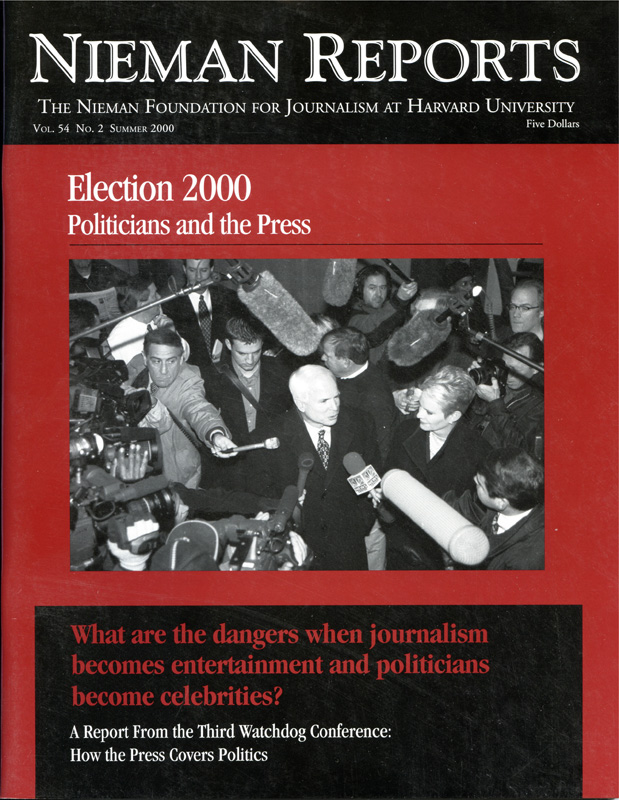
Election 2000: Politicians and the Press
It’s the tendency to focus on the celebrity, the character, not serious character but personality traits of political figures that trivializes the political process. So the focus of this discussion will be on issues which might be overlooked or underreported in the 2000 campaigns. Issues like those that David Broder spoke of last May when he wrote in his column that it’s quite a trick for something to grow larger and at the same time become more invisible. Broder was talking about the health care issue then, but he might just as well have been talking about any one of a number of issues that loom ill-defined in the background of the campaign rhetoric that focuses on youthful indiscretions or political money.
– Nieman Curator Bill Kovach opening the political Watchdog Journalism conference
As the century began, political reporters flocked to the front porch of the Canton, Ohio home of President William McKinley to dispatch his words to readers. Now, 100 years later, the speed of technology and transport, along with changing perceptions of how politics can and should be covered, sends candidates hurtling from state to state (either in person or via the electronic media) and makes reporters wonder what kind of news their dispatches should contain.
In the minds of many of his colleagues, James “Scotty” Reston, The New York Times’s long-time political observer, got it right when he said of campaign correspondents, “The higher we flew, the less we knew.” From the front porch to trains, from buses to planes, as presidential campaigns found new ways to reach more voters, reporters sought fresh approaches to communicating the story. Presidential biographer Doris Kearns Goodwin chronicles some of these changes in remarks she delivered at the opening of the Newseum’s exhibit, “Every Four Years: Presidential Campaign Coverage, 1896-2000.”
Then we hear from journalists, young and old, national and local, print, radio and Internet, about coverage of the 2000 election cycle and related topics. Evan Thomas, Assistant Managing Editor at Newsweek and Robert F. Kennedy biographer, describes the remotness of most presidential candidates today and the impact on press coverage. Jack W. Germond, syndicated columnist with The (Baltimore) Sun, ponders whether solid political reporters are a vanishing breed. Jack Nelson, the Los Angeles Times’s Chief Washington Correspondent, directs our attention to more of Germond’s thoughts, gathered from his 40 years of covering politics, in his review of Germond’s book, “Fat Man in a Middle Seat.” And Martin Nolan, columnist for The Boston Globe, assesses New Hampshire coverage from his post in San Francisco.
Cartoonist Ward Sutton and an array of election observers examine the impact of celebrity and entertainment on political coverage. Cragg Hines, Washington Bureau Chief of the Houston Chronicle, ponders the position of second tier candidates posturing for coverage, and Mike Mulcahy, Senior Political Editor at Minnesota Public Radio, details the combative relationship Governor Jesse Ventura has with the press. Mike Riley, Editor of The Roanoke (Va.) Times, describes what it means for all politics, including its coverage, to be local.
Former ABC News political correspondent Kathleen deLaski recalls her journey from TV to the Internet, where she heads American Online’s political coverage of the 2000 election. Mark Stencel, Editor of washingtonpost.com’s OnPolitics, reminds us that interactivity is a given in the new media’s coverage of politics, and Salon.com’s Washington Correspondent Jake Tapper relives his memorable ride on John McCain’s Straight Talk Express. National Public Radio reporter Peter Overby follows the candidates’ money trail and Diane Renzulli, Director of State Projects at the Center for Public Integrity, explains why press scrutiny of state legislators should be a central part of the statehouse beat.
Some of our photographs of the presidential primaries were taken by photojournalism students at Boston University and at the University of California, Berkeley.


